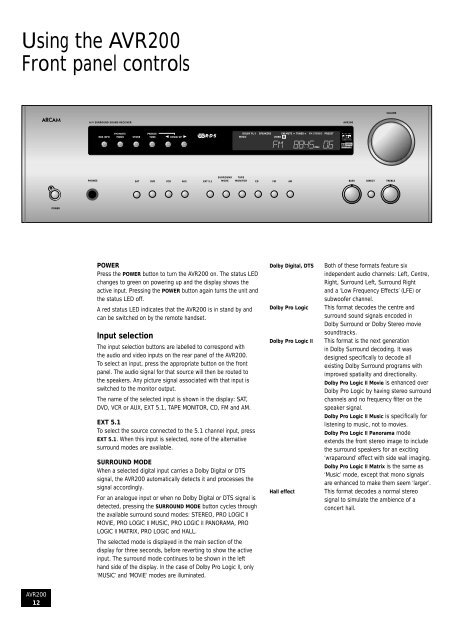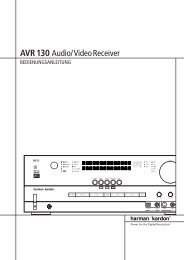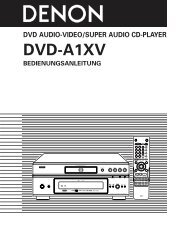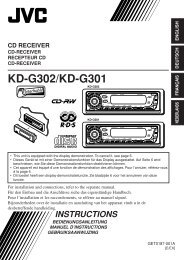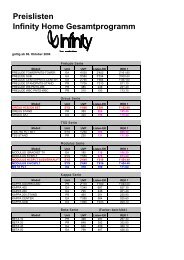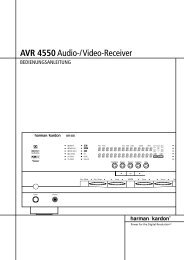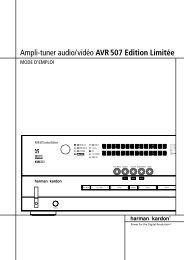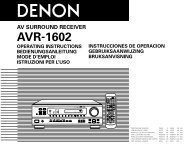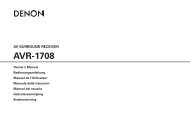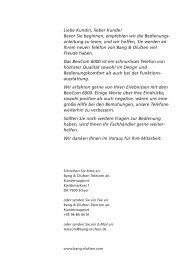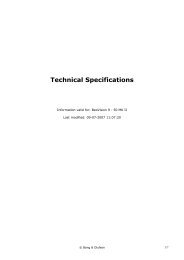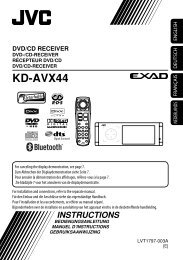Arcam AVR200 surround sound receiver Ampli-tuner audiovidéo ...
Arcam AVR200 surround sound receiver Ampli-tuner audiovidéo ...
Arcam AVR200 surround sound receiver Ampli-tuner audiovidéo ...
- No tags were found...
Create successful ePaper yourself
Turn your PDF publications into a flip-book with our unique Google optimized e-Paper software.
Using the <strong>AVR200</strong>Front panel controlsVOLUMEA/V SURROUND SOUND RECEIVER<strong>AVR200</strong>RDS INFOFM MUTE/MONOSTOREPRESET/TUNEDOWN/UPDOLBY PL II SPEAKERS FM MUTE TUNED FM STEREO PRESETMUSICVIDEO 1MHzPHONES SAT DVD VCR AUX EXT 5.1SURROUNDMODETAPEMONITOR CD FM AM BASS DIRECT TREBLEPOWERPOWERPress the POWER button to turn the <strong>AVR200</strong> on. The status LEDchanges to green on powering up and the display shows theactive input. Pressing the POWER button again turns the unit andthe status LED off.A red status LED indicates that the <strong>AVR200</strong> is in stand by andcan be switched on by the remote handset.Input selectionThe input selection buttons are labelled to correspond withthe audio and video inputs on the rear panel of the <strong>AVR200</strong>.To select an input, press the appropriate button on the frontpanel. The audio signal for that source will then be routed tothe speakers. Any picture signal associated with that input isswitched to the monitor output.The name of the selected input is shown in the display: SAT,DVD, VCR or AUX, EXT 5.1, TAPE MONITOR, CD, FM and AM.EXT 5.1To select the source connected to the 5.1 channel input, pressEXT 5.1. When this input is selected, none of the alternative<strong>surround</strong> modes are available.SURROUND MODEWhen a selected digital input carries a Dolby Digital or DTSsignal, the <strong>AVR200</strong> automatically detects it and processes thesignal accordingly.For an analogue input or when no Dolby Digital or DTS signal isdetected, pressing the SURROUND MODE button cycles throughthe available <strong>surround</strong> <strong>sound</strong> modes: STEREO, PRO LOGIC IIMOVIE, PRO LOGIC II MUSIC, PRO LOGIC II PANORAMA, PROLOGIC II MATRIX, PRO LOGIC and HALL.The selected mode is displayed in the main section of thedisplay for three seconds, before reverting to show the activeinput. The <strong>surround</strong> mode continues to be shown in the lefthand side of the display. In the case of Dolby Pro Logic II, only‘MUSIC’ and ‘MOVIE’ modes are illuminated.Dolby Digital, DTSDolby Pro LogicDolby Pro Logic IIHall effectBoth of these formats feature sixindependent audio channels: Left, Centre,Right, Surround Left, Surround Rightand a ‘Low Frequency Effects’ (LFE) orsubwoofer channel.This format decodes the centre and<strong>surround</strong> <strong>sound</strong> signals encoded inDolby Surround or Dolby Stereo movie<strong>sound</strong>tracks.This format is the next generationin Dolby Surround decoding. It wasdesigned specifi cally to decode allexisting Dolby Surround programs withimproved spatiality and directionality.Dolby Pro Logic II Movie is enhanced overDolby Pro Logic by having stereo <strong>surround</strong>channels and no frequency fi lter on thespeaker signal.Dolby Pro Logic II Music is specifi cally forlistening to music, not to movies.Dolby Pro Logic II Panorama modeextends the front stereo image to includethe <strong>surround</strong> speakers for an exciting‘wraparound’ effect with side wall imaging.Dolby Pro Logic II Matrix is the same as‘Music’ mode, except that mono signalsare enhanced to make them seem ‘larger’.This format decodes a normal stereosignal to simulate the ambience of aconcert hall.<strong>AVR200</strong>12


